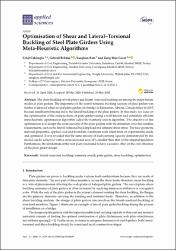Optimisation of shear and lateral-torsional buckling of steel plate girders using meta-heuristic algorithms
Abstract
The shear buckling of web plates and lateral-torsional buckling are among the major failure modes of plate girders. The importance of the lateral-torsional buckling capacity of plate girders was further evidenced when several plate girders of a bridge in Edmonton, Alberta, Canada failed in 2015, because insufficient bracing led to the lateral buckling of the plate girders. In this study, we focus on the optimisation of the cross-sections of plate girders using a well-known and extremely efficient meta-heuristic optimisation algorithm called the harmony search algorithm. The objective of this optimisation is to design the cross-sections of the plate girders with the minimum area that satisfies requirements, such as the lateral-torsional buckling load and ultimate shear stress. The base geometry, material properties, applied load and boundary conditions were taken from an experimental study and optimised. It was revealed that the same amount of load-carrying capacity demonstrated by this model can be achieved with a cross-sectional area 16% smaller than that of the original specimen. Furthermore, the slenderness of the web plate was found to have a decisive effect on the cost-efficiency of the plate girder design.

















